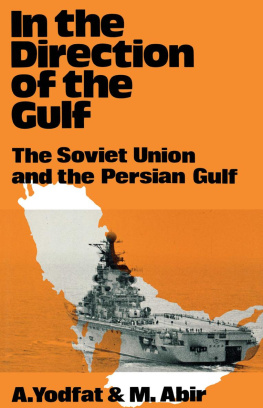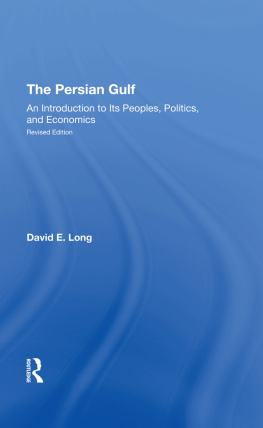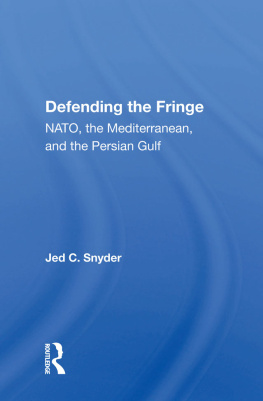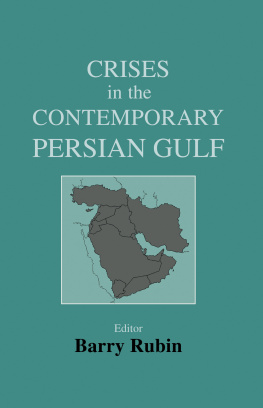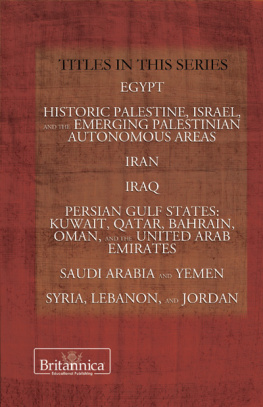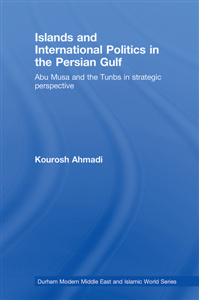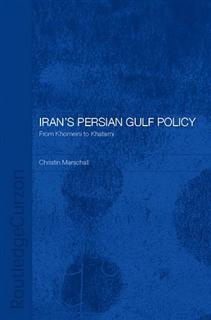IN THE DIRECTION OF THE PERSIAN GULF
In the Direction of the Persian Gulf
The Soviet Union and the Persian Gulf
A. Yodfat
and
M. Abir
First published 1977 in Great Britain and in the United States of America by
FRANK CASS AND COMPANY LIMITED
Published 2013
by Routledge
2 Park Square, Milton Park, Abingdon, Oxon OX14 4RN
711 Third Avenue, New York, NY 10017 USA
Routledge is an imprint of the Taylor & Francis Group, an informa business
Copyright 1977 A. Yodfat & M. Abir
ISBN 978-0-714-63071-7
ISBN 978-1-315-03472-0 (eISBN)
All rights reserved. No part of this publication may be reproduced in any form or by any means, electronic, mechanical, photocopying, recording or otherwise, without the prior written permission of the publisher.
Contents
Maps
Abbreviations
| ARAMCO | Arabian-American Oil Company |
| ASU | Arab Socialist Union (Egypt, Iraq) |
| CC | Central Committee |
| CENTO | Central Treaty Organization |
| CIA | Central Intelligence Agency (USA) |
| CMEA | Council for Mutual Economic Assistance (COMECON) |
| CP | Communist Party |
| CPR | Chinese People's Republic |
| CPSU | Communist Party of the Soviet Union |
| DPK | Democratic Party of Kurdistan |
| ELF | Eritrean Liberation Front |
| GDR | German Democratic Republic |
| GRU | Glavnoe Razvedovatel'noe Upravlenie, Main (Military) Intelligence Directorate (USSR) |
| ICP | Iraqi Communist Party |
| INOC | Iraqi National Oil Company |
| IPC | Iraq Petroleum Company |
| KGB | Komitet Gosudarstvennoy Bezopasnosti, Committee for State Security (USSR) |
| ME | Middle East |
| NATO | North Atlantic Treaty Organization |
| NF | National Front, see: NLF |
| NLF | National Liberation Front (PDRY) |
| OAPEC | Organization of Arab Petroleum Exporting Countries |
| OECD | Organization for Economic Cooperation and Development |
| OPEC | Organization of Petroleum Exporting Countries |
| PDRY | People's Democratic Republic of the Yemen |
| PFLO | Popular Front for the Liberation of Oman |
| PFLOAG | Popular Front for the Liberation of Oman and the Arabian (Persian) Gulf |
| PLF | Popular Liberation Front, see: PFLOAG |
| PRSY | People's Republic of South Yemen |
| RAF | Royal Air Force (Britain) |
| TASS | Telegraph Agency of the Soviet Union |
| UAE | Union of Arab Emirates |
| UAR | United Arab Republic (Egypt) |
| YAR | Yemen Arab Republic |
The German Ambassador in Moscow, Count von der Schulenburg, reported that in their conversation on November 26, 1940, Molotov had said that the Soviet Government was prepared 'to accept the draft of the Four Power Pact... Provided that the area south of Batum and Baku in the general direction of the Persian Gulf is recognized as the centre of the aspirations of the Soviet Union'.
Documents from the Archives of the German Foreign Office
This book attempts to analyse the Soviet Union's interest in the countries of the Persian Gulf against the background of its relations with the Arab world, and the complexities of power politics. It examines, from the nineteenth century to the present, Russia's involvement in and efforts to gain at least a foothold, if not control of this oil-rich region. The emphasis is on relatively recent and current developments, and the earlier period is covered only briefly. Particular attention is paid to the Soviet Union's interest in Persian Gulf oil, and Russian fuel resources are also discussed. Although bilateral and, to some extent, multilateral local relations are closely examined, power politics in general and in the region and the Indian Ocean are not neglected.
In addition to Soviet sources, the authors have used the Arab and Western press, periodicals and monitoring services extensively. Other sources are used to a lesser extent.
This is the first attempt to deal methodically with the subject of the USSR's interest in and efforts to reach the Persian Gulf.
In addition to the authors' collaboration, M. Abir was editorially responsible for the book as a whole.
The authors are indebted to the Leonard Davis Institute for International Relations of the Hebrew University of Jerusalem for the generous assistance provided and without whose help this study could not have been undertaken.
Chapter I
Oil: The USSR and the Persian Gulf

Oil was discovered in the southwestern part of Persia in 1908, the year after the signing of the Anglo-Russian Agreement. It is doubtful if Britain would have consented to the terms of the Agreement if oil had been discovered earlier, because the 1907 treaty classified the oil-rich area and, in fact, the greater part of the Gulf littoral, as a neutral zone. The Persian Gulf, which Britain regarded as India's line of defence, had been only second in importance to the Suez Canal as a transportation route until then. After the discovery of oil in the area, it became important in its own right, and together with the oil fields on the shores of the Gulf, required defence and protection. Even before World War I, the British had shifted from coal to oil as an energy source, and the importance of the Gulf during the War rose accordingly. British military operations in Mesopotamia were, to a considerable extent, directed toward protecting Persian oil fields.
Oil was also an important factor in the Turkish-German military campaigns in the Caucasus during the first years of World War I and in the British campaigns in that area after the November 1917 Bolshevik rise to power. Each nation had as its goal control of the oil fields at Baku.
Soviet forces entered Baku in April 1920. Its oil fields were nationalized, gradually reconstructed and developed as a Soviet state trust to become the main source of Soviet oil.
There was a marked decline in Russian oil production in 1917, the year of the Revolution, a much greater decline during the civil war, and only in 1926 did production approach the pre-Revolutionary level. Much oil was exported, as it was the largest single source of foreign exchange; about 20 per cent of all exports by value.
Western oil companies first tried to end the Soviet regime and regain their nationalized oil fields and concessions. When the regime began to look strong and unlikely to be replaced, attempts were made by the companies to have concessions awarded to them. When that also failed, they tried at least to purchase large quantities of Soviet oil. The success or failure of such attempts determined their attitudes and, to a great extent, those of their respective governments to the USSR and the Soviet regime, to the decisions to cooperate or boycott, to be friendly or hostile. As one observer described the situation in 1926:

